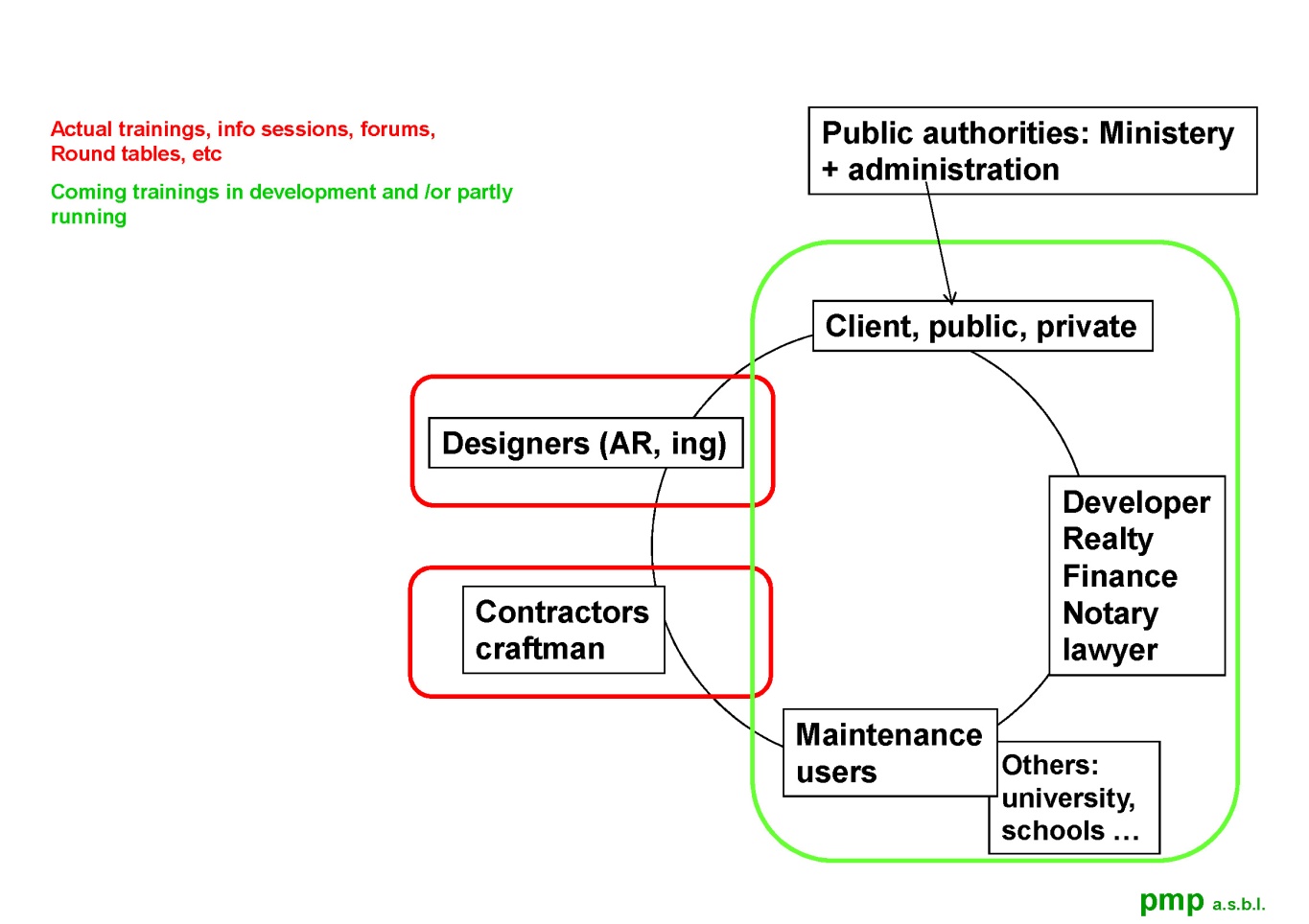Courses in higher education institutions: involvement of all stakeholders
Since the passive standard became a compulsory norm in the Brussels-Capital Region, there arose a need to train building sector professionals via universities, vocational schools, and various training centres. Nowadays, there are a few training initiatives for passive house and NZEB. Some are organized by Brussels Environment, some by PMP/PHP, and others at different training centres and educational facilities in the Brussels region. A broad-spectrum commitment is the only way to ensure that all the sector’s stakeholders receive the necessary training. As part of the “standardisation” of the passive standard, it is essential to work via partnerships with all stakeholders concerned: federations, training centres, associations, universities, vocational schools, etc. What remains to be done is to extend the training program to secondary and primary schools.
In relation to the bulk of the project and the standardisation of the compulsory passive standard, the sector has already reacted by requesting the introduction of certification and quality insurance process.
The quantity and diversity related to know-how about the passive standard require the integration of the quality control processes that already exist for all public buildings (in Brussels Region) or on a voluntary basis in the private sector. Thus, current control bodies have assimilated the passive standard.
There are European norms for training and execution of the work (NBN EN ISO/IEC 17020:2004 replacing EN 45004) and certification of persons (NBN EN ISO/IEC 17024). Launching the CoQual label (construction quality certification) has been a Belgian national initiative.
In 2009, Brussels Environment decided to develop a professional development program for conceptors, engineers, architects, and contracting authorities. A core premise of the training is a very good conception of a building. Thus, in the Brussels-Capital Region, PMP introduced training for designers in 2005, and for builders in 2007. Today, the training program involves the entire sector (developers, investors and promoters, building managers, property managers, notaries, maintenance companies, etc.) With the help of experts, Brussels Environment spends 18.000 training hours each year on topics of energy, material, water management, biodiversity, land use, and comfort, among others. PMP’s training program enables contractors to talk (train) other contractors, investors to talk (train) investors, etc.
PMP has also been very active in organizing a variety of training courses. Passivehouse training at PMP is tailored to the client: this is necessary because, for instance, tertiary sector clients have different needs from private individuals. For the tertiary sector, PMP has created specific guidelines. PMP officials consider that tailoring training programs is as important as it is appreciated. Awareness raising is also crucial, because many misconceptions persist about passive houses.
In PMP training, there are designer and construction cycles (standard), as well as advanced cycles, so as to suit participants who come into the trainings from different levels. There are also targeted training sessions, which cover very specific topics, as well as personalized guidance (personal sessions), and roundtables with a variety of stakeholders. But training clients alone is not enough. What is important is to foster exchanges between the different industries, to start a common dialogue between constructors, architects, clients, designers, etc.
The PMP designer cycles aims to foster sustainable passive building. It is a global vision: it requires providing a much more complex explanation than just the need to “build passive.” People need to be able to situate the issue within a broader context (global climate, EU policy), as well as to have specific information on materials, mobility, etc. So it does not make sense to focus on passive building only. That’s why the trainings speak of a global vision. The lectures are not very technical, but general vision is important: people should know exactly why they are asked to build passive, and why they are being asked to change their habits.
For designers and builders, the concrete value added of the training lies in the opportunity to apply the learned concepts into practice. During the very last day of the training, participants spend a day together, collaborating on a project to build a typical “passive” construction.
As regards higher education courses, at the Department of Architecture of the Université Libre de Bruxelles, PMP has integrated passivehouse training, which is separated in different levels, as follows:
• Level BA2: All the basics required regarding thermics, techniques, etc. • Level BA3: From “business as usual” towards a typical “passivehouse”: Details and passivehouse construction site visits. • Level MA1: Building Physics, including PHPP, Wufi, and thermal bridges. • Level Ma1 and MA2: LCA, urban sustainable development, etc. and passivehouse construction site visits.
The higher education course program was an initiative of two professors: Bernard Deprez, member of PMP and BEPASSIVE magazine Board of Directors, and Sebastian Moreno-Vacca, also a PMP board member, and editor of BEPASSIVE magazine.
